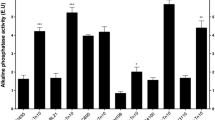Abstract
In contrast to stringent (relA+) cells of Escherichia coli, relaxed (relA) cells excreted recombinant proteins (β-lactamase, interferon α1) into the culture medium during amino acid limitation. Comparative analyses of overall fatty acid composition in relA+ cells and relA cells were performed and revealed that, in wild-type cells, drastic alterations occurred during the stringent response. The portion of saturated fatty acids (C16:0) and the fractions of cyclopropane fatty acids (C17cyc and C19cyc) increased whereas the portions of unsaturated fatty acids (C16:1 and C18:1) decreased. In cells of the relaxed mutant, no significant changes in the overall composition of the fatty acids were observed after the onset amino acid limitation. These results indicate that a change in fatty acid composition of membrane lipids after starvation of cells may be responsible for the prevention of loss of cellular proteins into the culture medium in stringent controlled cells of Escherichia coli.
Similar content being viewed by others
References
Arneborg N, Salskov-Iversen AS, Mathiasen TE (1993) The effect of growth rate and other growth conditions on the lipid composition of Escherichia coli. Appl Microbiol Biotechnol 39:353–357
Bligh EG, Dyer WJ (1959) A rapid method of total lipid extraction and purification. Can J Biochem Physiol 37:911–917
Breitling R, Gerlach D, Hartmann M, Behnke D (1989) Secretory expression in Escherichia coli and Bacillus subtilis of human interferon α genes directed by staphylokinase signals. Mol Gen Genet 217:384–391
Cashel M, Rudd KE (1987) The stringent response. In: Neidhardt FC (ed) Escherichia coli and Salmonella typhimurium cellular and molecular biology, vol 2, ASM, Washington DC, pp 1410–1438
Cronan JE (1968) Phospholipid alterations during growth of Escherichia coli. J Bacteriol 95:2054–2061
Cronan JE, Rock CO (1987) Biosynthesis of membrane lipids. In: Neidhardt FC (ed) Escherichia coli and Salmonella typhimurium cellular and molecular biology, vol 1, ASM, Washington DC, pp 474–497
Diefenbach R, Keweloh H (1994) Synthesis of trans unsaturated fatty acids in Pseudomonas putida P8 by direct isomerization of the double bond of lipids. Arch Microbiol (in press)
Diefenbach R, Heipieper HJ, Keweloh H (1992) The conversion of cis into trans unsaturated fatty acids in Pseudomonas putida P8: evidence for a role in the regulation of membrane fluidity. Appl Microbiol Biotechnol 38:382–387
Fill N, Friesen JD (1968) Isolation of “relaxed” mutants of Escherichia coli. J Bacteriol 95:729–731
Grogan DW, Cronan JE (1986) Characterization of Escherichia coli mutants completely defective in synthesis of cyclopropane fatty acids. J Bacteriol 166:872–877
Guckert JB, Hood MA, White DC (1986) Phospholipid ester-linked fatty acid profile changes during nutrient deprivation of Vibrio cholerae: increases in the trans/cis ration and proportions of cyclopropyl fatty acids. Appl Environ Microbiol 52:794–801
Macdonald PM, Sykes BD, McElhaney RN (1985) Fluorine-19 nuclear magnetic resonance studies of lipid fatty acyl chain order and dynamics in Acholeplasma laidlawii B membranes. A direct comparison of the effects of cis and trans cyclopropane ring and double-bond substituents on oriental order. Biochemistry 24:4651–4659
Magnuson K, Jackowski S, Rock CO, Cronan JE (1993) Regulation of fatty acid biosynthesis in Escherichia coli. Microbiol Rev 57:522–542
Mendoza D de, Cronan JE Jr (1983) Thermal regulation of membrane lipid fluidity in bacteria. Trends Biochem Sci 8:49–52
Merlie JP, Pizer LI (1973) Regulation of phospholipid synthesis in Escherichia coli by guanosine tetraphosphate. J Bacteriol 116:355–366
O'Callaghan CH, Morris H, Kirby SM, Shingler AH (1972) Novel method for detection of β-lactamase by using a chromogenic cephalosporin substrate. Antimicrob Agents Chemother 1:283–288
Polakis SE, Guchhait RB, Lane MD (1973) Stringent control of fatty acid synthesis in Escherichia coli: possible regulation of acetyl CoA carboxylase by ppGpp. J Biol Chem 248: 7957–7966
Riethdorf S, Ulrich A, Völker U, Hecker M (1990) Excretion into the culture medium of a Bacillus β-glucanase after overproduction in Escherichia coli. Z. Naturforsch 45[C]:240–244
Seyfzadeh M, Keener J, Nomura M (1993) spoT-dependent accumulation of guanosisne tetraphosphate in response to fatty acid starvation in Escherichia coli. Proc Natl Acad Sci USA 90:11004–11008
Stein JP, Bloch KE (1976) Inhibition of E. coli β-hydroxydecanoyl thioester dehydrase by ppGpp. Biochem Biophys Res Commun 73:881–884
Taguchi M, Izui K, Katsui H (1980) Augmentation of cyclopropane fatty acid synthesis under stringent control in Escherichia coli. J Biochem 88:1879–1882
Author information
Authors and Affiliations
Rights and permissions
About this article
Cite this article
Gitter, B., Diefenbach, R., Keweloh, H. et al. Influence of stringent and relaxed response on excretion of recombinant proteins and fatty acid composition in Escherichia coli . Appl Microbiol Biotechnol 43, 89–92 (1995). https://doi.org/10.1007/BF00170628
Received:
Accepted:
Issue Date:
DOI: https://doi.org/10.1007/BF00170628




